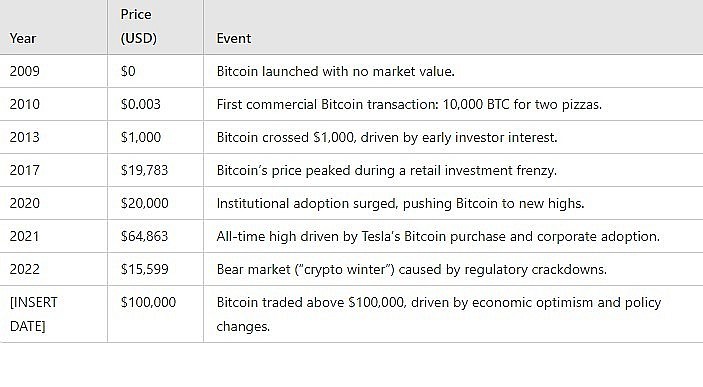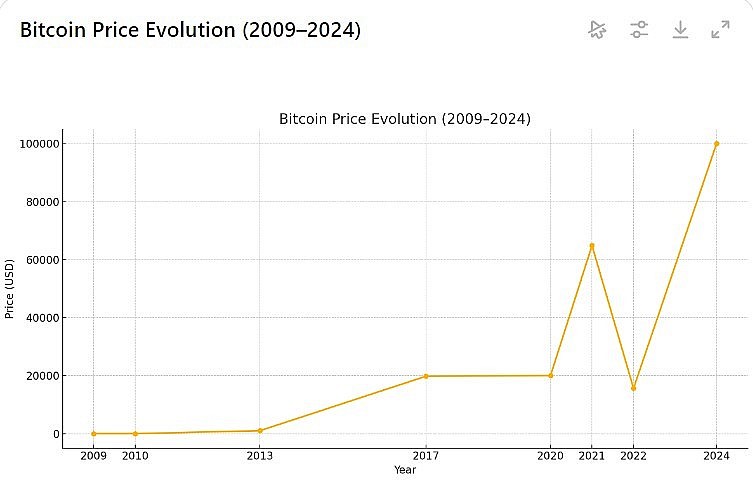Bitcoin: When Was It Created, Who is Creator, Price's Timeline
 Tax Implications of Utilizing Cryptocurrency in Business Transactions Tax Implications of Utilizing Cryptocurrency in Business Transactions |
 Top 10 Most Popular Cryptocurrencies In the U.K Today Top 10 Most Popular Cryptocurrencies In the U.K Today |
 |
| Who is the Father of Bitcoin? The Ongoing Debate |
What is Bitcoin
Bitcoin, the pioneer of cryptocurrency, has transformed the global financial landscape since its introduction in 2009. With its promise of decentralization and financial independence, Bitcoin has captivated investors, technologists, and economists alike.
On late Wednesday in [INSERT SPECIFIC DATE], Bitcoin broke the $100,000 mark for the first time. The surge was fueled by optimism surrounding President-elect Donald Trump's anticipated economic policies, which many believed would boost the adoption of cryptocurrencies. This historic milestone not only marked Bitcoin's entry into the mainstream consciousness but also reaffirmed its potential as a store of value and an investment vehicle.
The $100,000 Milestone
Bitcoin’s breakthrough above $100,000 represents a culmination of years of increasing adoption, institutional involvement, and market optimism. Factors contributing to this achievement include:
Political and Economic Policies: Expectations that Trump’s policies would stimulate growth in blockchain and cryptocurrency markets.
Institutional Adoption: A wave of investments by companies and financial institutions has legitimized Bitcoin as a hedge against inflation.
Scarcity and Demand: Bitcoin’s capped supply of 21 million coins continues to create scarcity, driving prices higher.
Technological Innovation: Advancements in blockchain technology and security have made Bitcoin increasingly appealing.
This milestone underscores Bitcoin’s role as a disruptor in global finance and its growing appeal to both retail and institutional investors.
Bitcoin: When Was It Created?
Bitcoin was launched on January 3, 2009, when its pseudonymous creator, Satoshi Nakamoto, mined the genesis block. This event marked the birth of a decentralized, peer-to-peer currency free from traditional financial intermediaries.
The genesis block contained a cryptic message:
"The Times 03/Jan/2009 Chancellor on brink of second bailout for banks."
This message, referencing the UK’s financial crisis, symbolized Bitcoin’s ethos: to offer an alternative to traditional banking systems plagued by inefficiencies, corruption, and centralization.
Bitcoin’s whitepaper, titled Bitcoin: A Peer-to-Peer Electronic Cash System, was published by Nakamoto in October 2008. It outlined Bitcoin's revolutionary use of blockchain technology, solving the double-spending problem inherent in earlier digital currencies.
Controversies Over Bitcoin's Creator
The true identity of Satoshi Nakamoto remains shrouded in mystery. Nakamoto disappeared from public communication in 2011, leaving behind an enigma that continues to fuel speculation. Some notable theories include:
Individual Theories
- Nick Szabo: Known for developing "Bit Gold," Szabo’s work predates and resembles Bitcoin. Linguistic analyses of his writing suggest similarities to Nakamoto, but Szabo denies involvement.
- Hal Finney: An early Bitcoin developer and the recipient of the first-ever Bitcoin transaction, Finney collaborated with Nakamoto and shares several ideologies central to Bitcoin.
- Dorian Nakamoto: A Japanese-American physicist accidentally implicated by media, Dorian denied involvement and claimed no knowledge of Bitcoin.
Group Theories
Some believe Nakamoto could represent a group of developers or even a government agency, given the sophistication of Bitcoin’s technology.
Regardless of Nakamoto’s identity, the Bitcoin community often views this anonymity as a feature, ensuring decentralization and a focus on the technology rather than its creator.
Bitcoin Price Fluctuations: A Detailed Timeline
Bitcoin’s price has undergone dramatic fluctuations, reflecting its growing adoption and inherent volatility. Below is a detailed timeline highlighting significant price milestones:
 |
| Bitcoin’s price journey |
Chart: Bitcoin Price Trends
Let’s visualize Bitcoin’s price evolution over the years:
 |
| Bitcoin Price Evolution (2009–2024) |
Additional Insights
Bitcoin’s impact transcends its financial use case. Here are key areas where Bitcoin has influenced global developments:
Decentralized Finance (DeFi): Bitcoin paved the way for DeFi platforms, enabling financial services without intermediaries.
Regulation and Legalization: Countries like El Salvador have made Bitcoin legal tender, while others explore central bank digital currencies (CBDCs).
Technological Innovation: Bitcoin’s blockchain has inspired advancements in distributed ledger technology, impacting industries like healthcare, logistics, and gaming.
Criticism: Concerns about energy consumption due to Bitcoin mining persist. However, initiatives like renewable-energy-powered mining seek to mitigate this impact.
Conclusion
Bitcoin’s rise to $100,000 is a historic achievement that underscores its transformative potential. From its origins as an alternative currency to its current status as a global financial phenomenon, Bitcoin continues to challenge and redefine traditional economic systems.
While its future remains uncertain, the $100,000 milestone demonstrates Bitcoin's resilience, innovation, and growing importance in the modern financial landscape.
FAQs
1. Who created Bitcoin?
Bitcoin was created by the pseudonymous Satoshi Nakamoto, whose identity remains unknown.
2. When did Bitcoin first trade above $100,000?
Bitcoin traded above $100,000 for the first time late Wednesday in [INSERT DATE], driven by optimism surrounding U.S. economic policy under President-elect Donald Trump.
3. Why is Bitcoin so valuable?
Bitcoin’s value stems from its decentralized nature, capped supply of 21 million coins, and increasing adoption as a store of value and digital asset.
4. How does Bitcoin impact the economy?
Bitcoin offers an alternative to traditional finance, enabling decentralized transactions, financial inclusion, and protection against inflation.
5. What are Bitcoin’s main criticisms?
Critics highlight Bitcoin’s energy consumption, regulatory uncertainty, and price volatility.
 Top 10 Most Popular CryptoCurrencies in the World Top 10 Most Popular CryptoCurrencies in the World Blockchain has entered into individual usage areas, and one of them is cryptocurrencies (digital currencies, digital money, electronic money or electronic currency). Stay tuned ... |

























